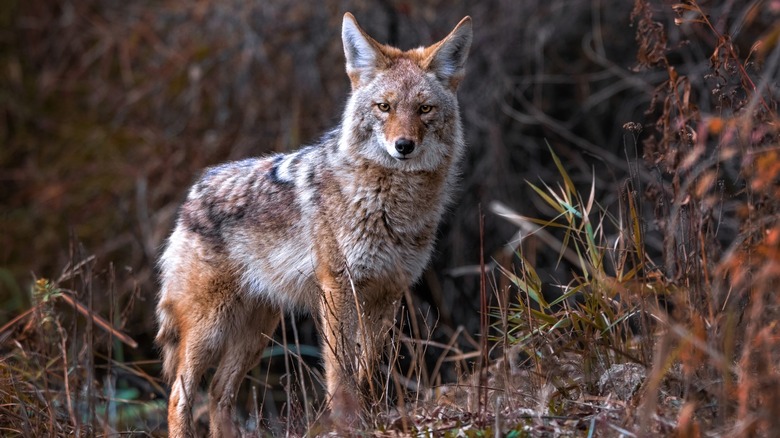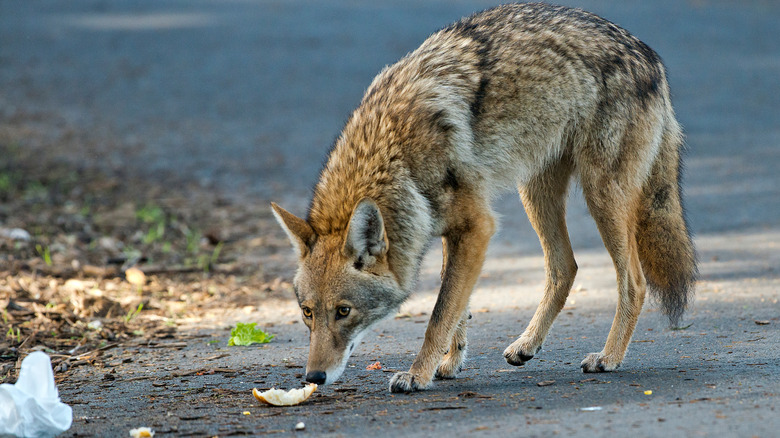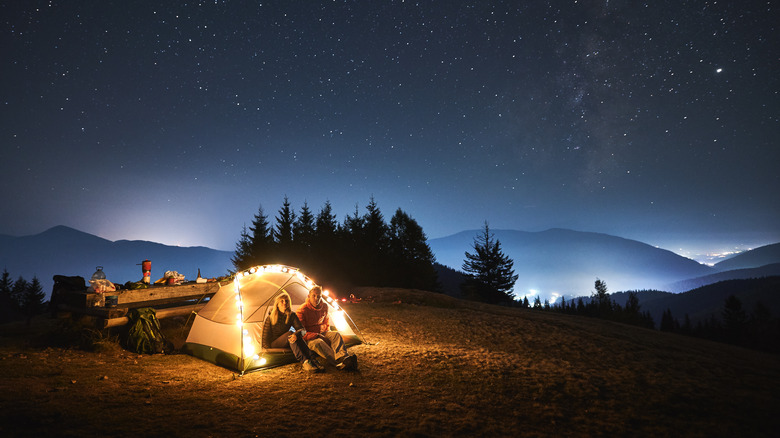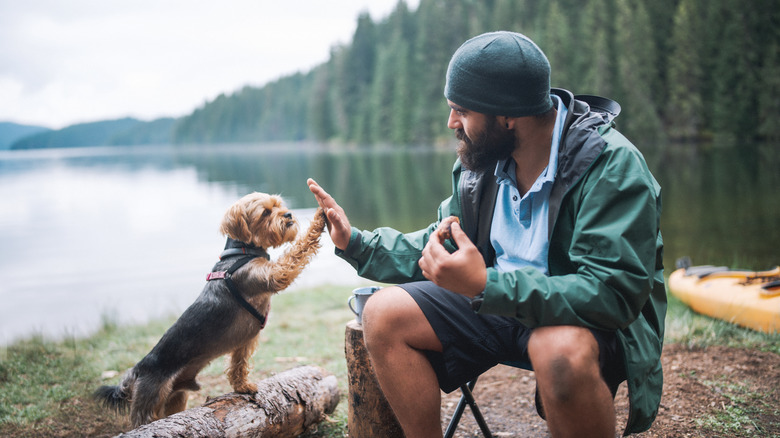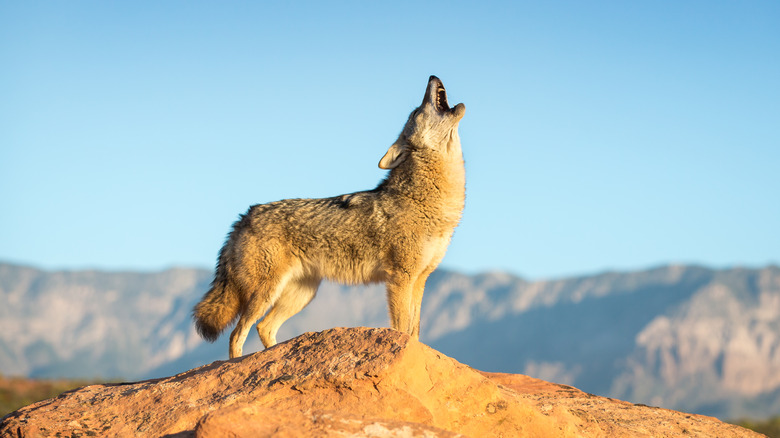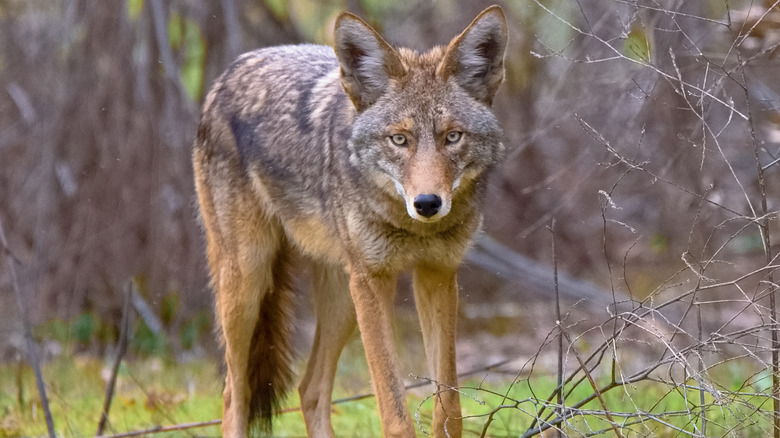How To Protect Your Campsite From Coyotes At Night
Camping is a great way to disconnect from the hustle and bustle of the modern world and spend time de-stressing while surrounded by nature. However, while nature is beautiful, it is also powerful and you always run the risk (albeit small) of encountering wild animals whenever you step into their habitat, whether it's a mountain lion, a brown bear, or a coyote. And, if you had to choose between those three options, a coyote encounter definitely seems like the safest bet because these scavenging canines tend to be skittish and prefer to avoid humans.
However, with the growth of the coyote population in recent years, the territory covered by these canines has expanded, causing coyote-human encounters to occur more frequently. While an aggressive encounter with a coyote is very rare, it is possible and has been happening more often — especially in areas where coyotes have learned to get food from humans (whether that's from rummaging through our trash or being hand-fed by tourists). So, if you are heading out to camp in coyote territory, it's a good idea to know how to keep these critters away from your campsite both for their safety and yours.
Store food and trash away from your campsite
The first and most important thing you can do to ensure coyotes are not drawn to your campsite is to keep it clean and store any trash or leftover food properly. Coyotes are scavengers and many have learned that human-inhabited areas contain tasty scraps. To make sure they don't come looking at your campsite, you should store food in airtight containers and keep it in an area away from your tent (ideally tied up in a tree or inside your car).
You can even consider avoiding meat entirely and eating your meal away from your tent. This way, your cooking and eating area will be separate from your sleeping area, and if any coyotes come sniffing, you won't be nearby. The National Park Service recommends setting up your cooking area around 100 yards away from your sleeping area whenever you are in the backcountry.
The same goes for trash, and you will want to make sure that any garbage is kept far away from your sleeping area. Many campsites have specific trash containers that are made to be animal-proof and are a great place to put all your food scraps. If you are camping out in the backcountry with no designated place to store garbage, then the second-best option is to bag it yourself and hang it in a tree away from your camp.
Choose an open area and add light
Choosing the right place to pitch your tent can make a big difference in whether you have curious nighttime visitors or not. In general, if you don't want coyotes in your campsite, you should choose an open and flat area as your home for the night. This is the best option because coyotes are normally rather timid and will prefer approaching your camp under the cover of vegetation or trees if possible. To avoid wildlife encounters in general, you should also put some distance between yourself and the nearest fresh water source and make sure to inspect your tent for any tears or holes before using it.
Also, coyotes are nocturnal and have evolved to see best at night, so having a campfire or a few lights around your tent in the evening is a great way to help you see better while deterring coyotes from getting close. Setting motion-activated lights is also a good way to scare off a coyote while letting you know that something is trying to enter your campsite at the same time.
Be careful with pets
Besides food and trash, camping with pets is one of the biggest reasons why a coyote might be drawn to your campsite to investigate. Coyotes typically eat small animals like rabbits, rodents, reptiles, and wild turkeys, but urban coyotes have been known to go for small pets. So, if you have a pet that is under 25 pounds, it could be at risk of being seen as food by a hungry coyote. Because of this, it's important to always keep pets near you and on a leash. You should never let any small pet wander off in the darkness alone, even if it's just for a few minutes.
While small pets are at more risk of being eaten, larger dogs cause problems by drawing coyotes to your campsite. In the spring, coyotes may see large dogs as a threat to their young and become aggressive toward them. It's also important to know that coyotes and dogs can mate and bringing an unspayed female dog may draw male coyotes to the area while an unneutered male dog may escape your campsite to chase after a female coyote.
Set up coyote deterrents
Because coyotes are easily startled, there are plenty of ways to set up deterrents that can help keep these inquisitive scroungers out of your space. One easy thing you can do is hang wind chimes or bells around your camp area. This will work especially well if you are somewhere in the backcountry where most wild animals aren't used to such noises but if you are in a busy campsite, then you may just end up annoying your neighbors. Another option is to bring a motion-activated alarm that emits a high-pitched noise that humans can't hear but coyotes and other animals find annoying. However, if you have pets with you, this alarm will likely affect them just as much as it will the coyote.
Another option is to keep coyotes away with scents they dislike like vinegar or ammonia. You can do this by making a border around your campsite using one or both of those scents. Some websites also recommend using mothballs to keep coyotes away from an area. However, mothballs contain a strong pesticide that is quite bad for the environment and can easily leach into soil or contribute to air pollution. Plus, mothball fumes are dangerous for both people and pets and should not be inhaled.
What to do if a coyote is outside your tent
If you think there is a coyote in your campsite or somewhere near your tent, you should remain inside and try to scare it off. According to The Humane Society, the best way to do this is to yell loudly, blow a whistle, bang pots and pans together, shake something that rattles, or employ any other method that creates a decently loud and startling noise. If the coyote leaves the area, you should remain inside your tent as they sometimes return two or three times before they are scared off for good. A coyote will not be able to enter a tent that is properly closed, so stay calm and be persistent.
If you encounter a coyote while outside your tent, you should first attempt to scare the animal away by making loud noises. You can also throw objects like rocks and sticks at or near the coyote to make it back away and turn on any flashlights or lanterns nearby to make the animal feel as uncomfortable as possible. You should always face a coyote directly and never turn your back on it or run from it, as this may activate the animal's prey drive and cause it to chase you.
